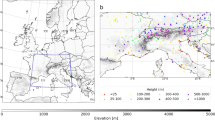Abstract
The Kwinana Coastal Fumigation Study took place inearly 1995 at Kwinana near Perth in Western Australia.The study involved surface and elevated meteorologicaland plume fumigation measurements in sea-breeze flowsnear the coast, and has yielded a comprehensive dataset that is suitable for assessing meteorological andplume dispersion models. In this paper, wesimulate the meteorology and turbulence on four casestudy days, and compare model results with thedetailed surface and aircraft measurements takenduring the study. These days had surface synopticwinds ranging from southerly to northeasterly, witheither stable or near-neutral temperature profilesover the sea.
The model used was based on that developed by Hurley(Boundary-Layer Meteorol. 83, 43–73, 1997), but extended here to allow domain nesting,optional non-hydrostatic simulations, and a vegetativecanopy at the surface. The model was forced bystandard weather service synoptic data, and thesimulations have captured the essential features ofthe strong sea-breeze circulation observed on thesedays. The boundary-layer structure over the sea waspredicted to be near-neutral or stable in agreementwith the observations on the particular day. The windspeed and direction in the sea-breeze flow weregenerally predicted well, although the predictedmaximum inflow speed over the land was a little toohigh. The potential temperature was generallyover-predicted, but temperature gradients agreed well.Predicted turbulence levels in the bottom-half of thethermal internal boundary layer compared well to theobservations, but under-estimated the observations inthe in the upper half of this layer. Near-surfacemeasurements of meteorological variables werepredicted well over the entire diurnal cycle, althoughthe predicted sea-breeze onset was generally tooearly. A quantitative model evaluation for thenear-surface sites showed the model performance to bebetter than that from other studies, with Index ofAgreement (IOA) values of 0.8 (wind speed) and 0.96(temperature), compared with values of 0.5–0.6 (windspeed) and 0.33 (temperature) obtained from otherstudies.
The availability of new higher resolution synopticanalyses should obviate the lack of spatial andtemporal resolution in synoptic inputs. Theincorporation of these higher resolution synopticinputs and new parameterisation schemes should improvefuture model performance.
Similar content being viewed by others
References
Davies, H.: 1976, ‘A Lateral Boundary Formulation for Multi-level Prediction Models’, Quart. J. Roy. Meteorol. Soc. 102, 405–418.
Grell, G. A., Dudhia, J., and Stauffer, D. R.: 1994, ‘A Description of the Fifth-Generation Penn State/NCAR Mesoscale Model (MM5)’, NCAR Technical Report No. 398, 120 pp.
Hurley P. J.: 1997, ‘An Evaluation of Several Turbulence Schemes for the Prediction of Mean and Turbulent Fields in Complex Terrain’, Boundary-Layer Meteorol. 83, 43–73.
Kowalczyk, E. A., Garratt, J. R., and Krummel, P. B.: 1991, ‘A Soil-canopy Scheme for Use in a Numerical Model of the Atmosphere – 1D Stand Alone Model’, CSIRO Division of Atmospheric Research Technical Report No. 23, 56 pp.
Luhar, A. K., Sawford, B. L., Hacker, J. M., and Rayner, K. N.: 1998, ‘The Kwinana Coastal Fumigation Study: II – Growth of the Thermal Internal Boundary Layer’, Boundary-Layer Meteorol. 89, 385–405.
Lyons, W. A., Tremback, C. J., and Pielke R. A.: 1995, ‘Applications of the Regional Atmospheric Modeling System (RAMS) to Provide Input to Photochemical Grid Models for the Lake Michigan Ozone Study (LMOS)’, J. Appl. Meteorol. 34, 1762–1786.
Mahrer, Y. and Pielke, R. A.: 1977, ‘A Numerical Study of the Airflow Over Irregular Terrain’, Beitr. Phys. Atmosph. 50, 98–113.
Physick, W. L., Noonan, J. A., McGregor, J. L., Hurley, P. J., Abbs, D. J., and Manins, P. C.: 1994, ‘LADM: A Lagrangian Atmospheric Dispersion Model’, CSIRO Division of Atmospheric Research Technical Report No. 24, 137 pp.
Pielke R. A.: 1984, Mesoscale Meteorological Modelling, Academic Press, Orlando, 612 pp.
Sawford, B. L., Luhar, A. K., Hacker, J. M., Young S. A., Yoon, I.-H., Noonan, J. A., Carras, J. N., Williams, D. J., and Rayner, K. N.: 1998, ‘The Kwinana Coastal Fumigation Study: I – Program Overview, Experimental Design and Selected Results’, Boundary-Layer Meteorol. 89, 359–384.
Seaman, N. L., Stauffer, D. R., and Lario-Gibbs, A. M.: 1995: ‘A Multi-scale Four Dimensional Data Assimilation System Applied in the San Joaquin Valley During SARMAP. Part I: Modeling Design and Basic Performance’, J. Appl. Meteorol. 34, 1739–1761.
Seaman, N. L., Stauffer, D. R., McNally, D. E., and Tanrikulu, S.: 1996: ‘Application of the MM5-FDDA Meteorological Model to the Southern California SCAQS-97 Domain: Preliminary Test Using the SCAQS August 1987 Case’, Preprints of the 9th Joint Conference on Applications of Air Pollution Meteorology with AWMA, Atlanta, Georgia, U.S.A., January 28–February 2, 1996.
Steyn, D. G. and McKendry, I. G.: 1988, ‘Quantitative and Qualitative Evaluation of a Threedimensional Mesoscale Numerical Model Simulation of a Sea Breeze in Complex Terrain’, Mon. Wea. Rev. 116, 1914–1926.
Ulrickson, B. L. and Mass, C. F.: 1990, ‘Numerical Investigation of Mesoscale Circulations over the Los Angeles Basin. Part I: A Verification Study’, Mon. Wea. Rev. 118, 2138–2161.
Willmott C. J.: 1981, ‘On the Validation of Models’, Phys. Geography 2, 184–194.
Author information
Authors and Affiliations
Rights and permissions
About this article
Cite this article
Hurley, P.J., Luhar, A.K. The Kwinana Coastal Fumigation Study: III – Meteorological and Turbulence Modelling on Selected Days. Boundary-Layer Meteorology 94, 115–138 (2000). https://doi.org/10.1023/A:1002446330340
Issue Date:
DOI: https://doi.org/10.1023/A:1002446330340




